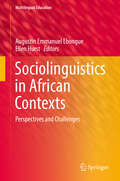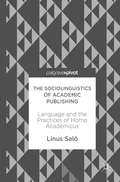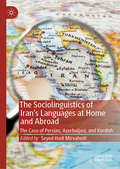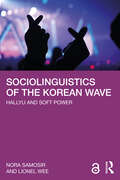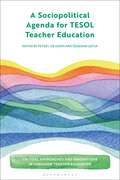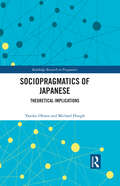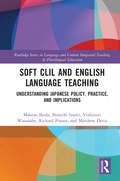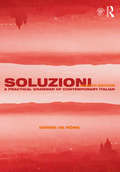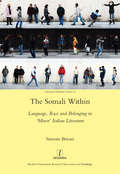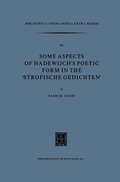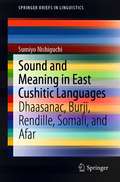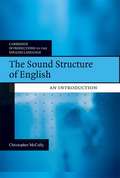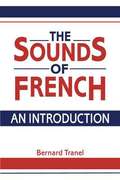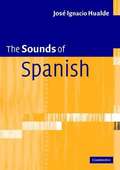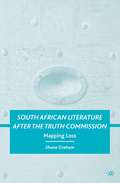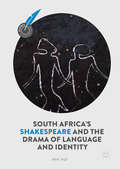- Table View
- List View
Sociolinguistics in African Contexts: Perspectives and Challenges (Multilingual Education #20)
by Augustin Emmanuel Ebongue Ellen HurstThis volume offers a new perspective on sociolinguistics in Africa. Eschewing the traditional approach which looks at the interaction between European and African languages in the wake of colonialism, this book turns its focus to the social dynamics of African languages and African societies. Divided into two sections, the book offers insight into the crucial topics such as: language vitality and endangerment, the birth of ‘new languages’, a sociolinguistics of the city, language contact and language politics. It spans the continent from Algeria to South Africa, Guinea-Bissau to Kenya and addresses the following broad themes: Language variation, contact and changeThe dynamics of urban, rural and youth languagesPolicy and practiceThis book provides an alternative to the Eurocentric view of sociolinguistic dynamics in Africa, and will make an ideal read or supplemental textbook for scholars and students in the field/disciplines of African languages and linguistics, and those interested in southern theory or ‘sociolinguistics in the margins’.
The Sociolinguistics of Academic Publishing: Language and the Practices of Homo Academicus
by Linus SalöThis book presents a sociolinguistics of academic publishing from an historical and contemporary perspective. Using Swedish academia as a case study, it focuses on publishing practices within history and psychology. The author demonstrates how new regimes of research evaluation and performance-based funding are impinging on university life. His central argument, following the French sociologist Bourdieu, is that the trend towards publishing in English should be understood as a social strategy, developed in response to such transformations. Thought-provoking and challenging, this book will interest students and scholars of sociolinguistics, language planning and language policy, research policy, sociology of science, history and psychology.
The Sociolinguistics of Academic Publishing: Language and the Practices of Homo Academicus
by Linus SalöThis book presents a sociolinguistics of academic publishing from an historical and contemporary perspective. Using Swedish academia as a case study, it focuses on publishing practices within history and psychology. The author demonstrates how new regimes of research evaluation and performance-based funding are impinging on university life. His central argument, following the French sociologist Bourdieu, is that the trend towards publishing in English should be understood as a social strategy, developed in response to such transformations. Thought-provoking and challenging, this book will interest students and scholars of sociolinguistics, language planning and language policy, research policy, sociology of science, history and psychology.
The Sociolinguistics of Iran’s Languages at Home and Abroad: The Case of Persian, Azerbaijani, and Kurdish
by Seyed Hadi MirvahediThis book examines the sociolinguistics of some of Iran’s languages at home and in the diaspora. The first part of the book examines the politics of minority languages and the presence of hegemonic discourses which favour Persian (Farsi) in Iran, exploring issues such as language maintenance and shift, linguistic ideologies and practices among Azerbaijani and Kurdish-speaking communities. The authors then go on to examine Iranians’ linguistic ideologies, practices and (trans)national identity construction in the diaspora, investigating both the challenges of maintaining a home language and the strategies and linguistic repertoires employed when constructing a diasporic identity away from home. This book will be of interest to students and scholars of minority languages and communities, diaspora and migration studies, and language policy and planning.
Sociolinguistics of the Korean Wave: Hallyu and Soft Power
by Nora Samosir Lionel WeeSamosir and Wee examine how the immensely popular Korean Wave ("K-wave") also known as Hallyu is wielded as soft power through the use of communication for persuasion and attraction on the global stage. The Korean Wave refers to the global spread and popularity of South Korean culture, particularly its pop music ("K-pop"), serialised dramas ("K-dramas") and films ("K-films"). Given the South Korean government’s involvement in providing funding and publicity, the Korean Wave raises interesting sociolinguistic questions about the relationship between artistry and citizenship, the use of social media in facilitating the consumption of cultural products, and, ultimately, the nature of soft power itself. Studies of soft power have tended to come from the field of international relations. This book shows that sociolinguistics actually has a number of tools in its conceptual arsenal – such as indexicality, stance taking, affect, and styling – that can shed light on the Korean Wave as a form of soft power. As the first book-length sociolinguistic analysis of the Korean Wave and soft power, this book demonstrates how K-pop, K-dramas, and K-films have been able to encourage in consumers an anthropological stance towards all things Korean. This volume will be of particular interest to students and scholars in sociolinguistics, political science, cultural studies, and Korean studies.
Sociolinguistics of the Korean Wave: Hallyu and Soft Power
by Nora Samosir Lionel WeeSamosir and Wee examine how the immensely popular Korean Wave ("K-wave") also known as Hallyu is wielded as soft power through the use of communication for persuasion and attraction on the global stage. The Korean Wave refers to the global spread and popularity of South Korean culture, particularly its pop music ("K-pop"), serialised dramas ("K-dramas") and films ("K-films"). Given the South Korean government’s involvement in providing funding and publicity, the Korean Wave raises interesting sociolinguistic questions about the relationship between artistry and citizenship, the use of social media in facilitating the consumption of cultural products, and, ultimately, the nature of soft power itself. Studies of soft power have tended to come from the field of international relations. This book shows that sociolinguistics actually has a number of tools in its conceptual arsenal – such as indexicality, stance taking, affect, and styling – that can shed light on the Korean Wave as a form of soft power. As the first book-length sociolinguistic analysis of the Korean Wave and soft power, this book demonstrates how K-pop, K-dramas, and K-films have been able to encourage in consumers an anthropological stance towards all things Korean. This volume will be of particular interest to students and scholars in sociolinguistics, political science, cultural studies, and Korean studies.
A Sociopolitical Agenda for TESOL Teacher Education (Critical Approaches and Innovations in Language Teacher Education)
by Peter I. De Costa and Özgehan UştukTeaching English to Speakers of Other Languages (TESOL) sits at the nexus of constant change, which makes it vitally important for language teachers to engage in continuous development and keep abreast of the sociopolitical milieu in which they are embedded. However, most teacher education activities are often associated with what is perceived as best practices that are expected to be adopted(often uncritically) for classroom application and practice, with the intention of training teachers to become technicians in their respective classrooms. In reality, TESOL practitioners often find themselvesin situations that require them to be reflexive practitioners and to negotiate sites of political struggles and social injustice.Given that a socially situated understanding of TESOL teacher education is often overlooked, this volume highlights the sociopolitical dimensions of TESOL teacher education. In Part 1, the authors introduce the theoretical underpinnings of the sociopolitical agenda proposed by this volume. Building on these theories, Part 2 realizes the proposed agenda by situating it within actual TESOL teacher education contexts that are characterized by power imbalances and neoliberally inflected educational injustices.
A Sociopolitical Agenda for TESOL Teacher Education (Critical Approaches and Innovations in Language Teacher Education)
Teaching English to Speakers of Other Languages (TESOL) sits at the nexus of constant change, which makes it vitally important for language teachers to engage in continuous development and keep abreast of the sociopolitical milieu in which they are embedded. However, most teacher education activities are often associated with what is perceived as best practices that are expected to be adopted(often uncritically) for classroom application and practice, with the intention of training teachers to become technicians in their respective classrooms. In reality, TESOL practitioners often find themselvesin situations that require them to be reflexive practitioners and to negotiate sites of political struggles and social injustice.Given that a socially situated understanding of TESOL teacher education is often overlooked, this volume highlights the sociopolitical dimensions of TESOL teacher education. In Part 1, the authors introduce the theoretical underpinnings of the sociopolitical agenda proposed by this volume. Building on these theories, Part 2 realizes the proposed agenda by situating it within actual TESOL teacher education contexts that are characterized by power imbalances and neoliberally inflected educational injustices.
Sociopragmatics of Japanese: Theoretical Implications (Routledge Research in Pragmatics)
by Yasuko Obana Michael HaughObana and Haugh question the extent to which commonly accepted theories in pragmatics can readily explain sociopragmatic phenomena in Japanese. Studies of Japanese in pragmatics have often challenged the cross-linguistic relevance of dominant theories. However, they have also inadvertently perpetuated stereotypes about the Japanese. It is often been assumed, for instance, that Japanese people are less strategic, more polite and more reliant on tacit forms of communication than speakers of other languages. But the Japanese are not as polite as one might think. The aim of this book is thus to question those folk assumptions around politeness, impoliteness, irony and indirectness while at the same time emphasizing that close examination of sociopragmatic phenomena in Japanese yields important empirical insights that combat common theoretical assumptions in pragmatics. The content is structured in three parts, in which the authors highlight a key building block of a theory of sociopragmatics. Part I focuses on indexing through the lens of chapters on honorifics, routine formula and politeness strategies. Part II focuses on evaluating through the lens of chapters on giving/receiving expressions and honorific irony. Finally, Part III focuses on relating through the lens of chapters on joint utterances and off record requests. Throughout the chapters the authors draw attention to ways in which these three dimensions are invariably intertwined in various ways. This book is not simply a collection of studies that promotes our understanding of the sociopragmatics of a particular language, but goes deeper and challenges what many have taken for granted in pragmatics. It proposes a framework for exploring sociopragmatic phenomena, building on the key sociopragmatic axes of indexing, evaluating and relating, and offers fresh new perspectives on time-honoured phenomena in pragmatics. It will interest scholars and postgraduate students in pragmatics, particularly those specializing in: politeness, impoliteness, indirectness and irony. The book explains what Japanese terms mean, and all the Japanese examples are morphologically-glossed. Therefore, teachers (and advanced learners) of Japanese at all levels will benefit from the book as it will enrich their knowledge of the Japanese language.
Sociopragmatics of Japanese: Theoretical Implications (Routledge Research in Pragmatics)
by Yasuko Obana Michael HaughObana and Haugh question the extent to which commonly accepted theories in pragmatics can readily explain sociopragmatic phenomena in Japanese. Studies of Japanese in pragmatics have often challenged the cross-linguistic relevance of dominant theories. However, they have also inadvertently perpetuated stereotypes about the Japanese. It is often been assumed, for instance, that Japanese people are less strategic, more polite and more reliant on tacit forms of communication than speakers of other languages. But the Japanese are not as polite as one might think. The aim of this book is thus to question those folk assumptions around politeness, impoliteness, irony and indirectness while at the same time emphasizing that close examination of sociopragmatic phenomena in Japanese yields important empirical insights that combat common theoretical assumptions in pragmatics. The content is structured in three parts, in which the authors highlight a key building block of a theory of sociopragmatics. Part I focuses on indexing through the lens of chapters on honorifics, routine formula and politeness strategies. Part II focuses on evaluating through the lens of chapters on giving/receiving expressions and honorific irony. Finally, Part III focuses on relating through the lens of chapters on joint utterances and off record requests. Throughout the chapters the authors draw attention to ways in which these three dimensions are invariably intertwined in various ways. This book is not simply a collection of studies that promotes our understanding of the sociopragmatics of a particular language, but goes deeper and challenges what many have taken for granted in pragmatics. It proposes a framework for exploring sociopragmatic phenomena, building on the key sociopragmatic axes of indexing, evaluating and relating, and offers fresh new perspectives on time-honoured phenomena in pragmatics. It will interest scholars and postgraduate students in pragmatics, particularly those specializing in: politeness, impoliteness, indirectness and irony. The book explains what Japanese terms mean, and all the Japanese examples are morphologically-glossed. Therefore, teachers (and advanced learners) of Japanese at all levels will benefit from the book as it will enrich their knowledge of the Japanese language.
Soft CLIL and English Language Teaching: Understanding Japanese Policy, Practice and Implications (Routledge Series in Language and Content Integrated Teaching & Plurilingual Education)
by Makoto Ikeda Shinichi Izumi Yoshinori Watanabe Richard Pinner Matthew DavisContent and Language Integrated Learning (CLIL) is a transformative and powerful approach to language education and has had a significant impact on educational pedagogy in recent years. Despite burgeoning literature on the efficacy and implementation of CLIL, there remains a gap between CLIL and English Language Teaching (ELT). Many practitioners wonder how they can ‘do CLIL’ if their main classes are focused on English as a Foreign Language (EFL). This volume addresses these concerns by examining the experiences of various CLIL practitioners in the EFL context of Japan. Chapters outline the CLIL methodology, the differences in ‘hard CLIL’ (subject led) and ‘soft CLIL’ (language-oriented) before focusing on the EFL interpretations of soft-CLIL. Although the distinction of hard CLIL and soft CLIL has been mentioned in several publications, this is the first book-length exploration of this issue, featuring chapters examining expectations, challenges, material support, implementation, and even motivation in CLIL classrooms. All of this culminates in a review of the potential and future of CLIL in EFL contexts, paving the way for more widespread and well informed implementation of CLIL all over the world.
Soft CLIL and English Language Teaching: Understanding Japanese Policy, Practice and Implications (Routledge Series in Language and Content Integrated Teaching & Plurilingual Education)
by Makoto Ikeda Shinichi Izumi Yoshinori Watanabe Richard Pinner Matthew DavisContent and Language Integrated Learning (CLIL) is a transformative and powerful approach to language education and has had a significant impact on educational pedagogy in recent years. Despite burgeoning literature on the efficacy and implementation of CLIL, there remains a gap between CLIL and English Language Teaching (ELT). Many practitioners wonder how they can ‘do CLIL’ if their main classes are focused on English as a Foreign Language (EFL). This volume addresses these concerns by examining the experiences of various CLIL practitioners in the EFL context of Japan. Chapters outline the CLIL methodology, the differences in ‘hard CLIL’ (subject led) and ‘soft CLIL’ (language-oriented) before focusing on the EFL interpretations of soft-CLIL. Although the distinction of hard CLIL and soft CLIL has been mentioned in several publications, this is the first book-length exploration of this issue, featuring chapters examining expectations, challenges, material support, implementation, and even motivation in CLIL classrooms. All of this culminates in a review of the potential and future of CLIL in EFL contexts, paving the way for more widespread and well informed implementation of CLIL all over the world.
Soluzioni: A Practical Grammar of Contemporary Italian (Routledge Concise Grammars)
by Denise De RomeSoluzioni: A Practical Grammar of Contemporary Italian combines an engaging reference and practice grammar explained in clear and concise language with numerous supporting exercises.Aimed at keen students of all levels, Soluzioni offers: a complete grammar review in tabular form for easy navigation and at-a-glance comprehension; 650 graded practice exercises with an answer key for self-assessment; extensive examples, using a wide range of useful up-to-date vocabulary; authentic material from Italian media and literature, with vocabulary notes and linked exercises to show how grammar works in practice; special help sections throughout, dedicated to clarifying tricky points or avoiding common pitfalls; a comprehensive user-friendly index for ease of access in both Italian and English; a glossary of grammatical terms; a companion website at www.routledge.com/cw/derome with over 240 free interactive language quizzes for on-the-spot testing, plus supplementary downloadable material such as a comprehensive verb section and full answer key to the book exercises. This fourth edition continues the accessible methodology and focus on contemporary usage that has made Soluzioni the clearest and most comprehensive pedagogic grammar on the market today. Fully updated, it covers key areas of difficulty such as tense usage, the subjunctive, causative verbs, combined pronouns and word order. It also pays attention to the links between grammar and communicative functions as well as those between grammar, context and register. Suitable for class use and independent study, Soluzioni is the ideal reference and practice resource for learners of Italian. It is particularly suitable for fast-track use in ab initio courses at university and college.
Soluzioni: A Practical Grammar of Contemporary Italian (Routledge Concise Grammars)
by Denise De RomeSoluzioni: A Practical Grammar of Contemporary Italian combines an engaging reference and practice grammar explained in clear and concise language with numerous supporting exercises. Aimed at keen students of all levels, Soluzioni offers: a complete grammar review in tabular form for easy navigation and at-a-glance comprehension; 650 graded practice exercises with an answer key for self-assessment; extensive examples, using a wide range of useful up-to-date vocabulary; authentic material from Italian media and literature, with vocabulary notes and linked exercises to show how grammar works in practice; special help sections throughout, dedicated to clarifying tricky points or avoiding common pitfalls; a comprehensive user-friendly index for ease of access in both Italian and English; a glossary of grammatical terms; a companion website at www.routledge.com/cw/derome with over 240 free interactive language quizzes for on-the-spot testing, plus supplementary downloadable material such as a comprehensive verb section and full answer key to the book exercises. This fourth edition continues the accessible methodology and focus on contemporary usage that has made Soluzioni the clearest and most comprehensive pedagogic grammar on the market today. Fully updated, it covers key areas of difficulty such as tense usage, the subjunctive, causative verbs, combined pronouns and word order. It also pays attention to the links between grammar and communicative functions as well as those between grammar, context and register. Suitable for class use and independent study, Soluzioni is the ideal reference and practice resource for learners of Italian. It is particularly suitable for fast-track use in ab initio courses at university and college.
The Somali Within: Language, Race and Belonging in Minor Italian Literature
by Brioni SimoneThe recent histories of Italy and Somalia are closely linked. Italy colonized Somalia from the end of the 19th century to 1941, and held the territory by UN mandate from 1950 to 1960. Italy is also among the destination countries of the Somali diaspora, which increased in 1991 after civil war. Nonetheless, this colonial and postcolonial cultural encounter has often been neglected. Critically evaluating Gilles Deleuze and F x Guattari‘s concept ofminor literature as well as drawing on postcolonial literary studies, The Somali Within analyses the processes of linguistic and cultural translation and self-translation, the political engagement with race, gender, class and religious discrimination, and the complex strategies of belonging and unbelonging at work in the literary works in Italian by authors of Somali origins. Brioni proposes that theminor Somali Italian connection might offer a major insight into the transnational dimension of contemporaryItalian literature andSomali culture.
The Somali Within: Language, Race and Belonging in Minor Italian Literature
by Brioni SimoneThe recent histories of Italy and Somalia are closely linked. Italy colonized Somalia from the end of the 19th century to 1941, and held the territory by UN mandate from 1950 to 1960. Italy is also among the destination countries of the Somali diaspora, which increased in 1991 after civil war. Nonetheless, this colonial and postcolonial cultural encounter has often been neglected. Critically evaluating Gilles Deleuze and F x Guattari‘s concept ofminor literature as well as drawing on postcolonial literary studies, The Somali Within analyses the processes of linguistic and cultural translation and self-translation, the political engagement with race, gender, class and religious discrimination, and the complex strategies of belonging and unbelonging at work in the literary works in Italian by authors of Somali origins. Brioni proposes that theminor Somali Italian connection might offer a major insight into the transnational dimension of contemporaryItalian literature andSomali culture.
Some Aspects of Hadewijch’s Poetic form in the ‘Strofische Gedichten’ (Bibliotheca Neerlandica extra muros #3)
by Tanis M. GuestSophocles: Antigone (Aris & Phillips Classical Texts)
by Andrew Lyon BrownSophocles’ Antigone is among the greatest and most famous of all works of Greek literature, and it is often the play that is read first, whether in Greek or in translation, by those who are beginning to study Greek tragedy. But it is by no means an easy play, and readers requires careful guidance if they are to appreciate its subtleties and come to grips with its problems. In this edition the introduction includes an account of the myth, a brief survey of the main interpretative issues, and a bibliography. The text is newly constituted in the light of the latest scholarly research, with an abbreviated critical apparatus. The facing translation stays as close to the Greek wording as English idiom allows, one of its purposes being to show how the Greek is to be construed. The commentary is designed to elucidate the play, not to discuss points of grammar or philology, though the reader is alerted to all serious textual uncertainties. While full account is taken of recent developments in scholarship and literary criticism, the needs of the complete beginner are constantly borne in mind, and almost all the notes are accessible to readers with no Greek at all. Copious references are provided to places where further discussion can be found. Greek text with facing-page English translation, introduction and commentary.
Sophocles: Philoctetes (Aris & Phillips Classical Texts)
by R. G. UssherPhiloctetes is a tragedy of surpassing human interest. It is played out almost entirely between a man and a boy, the former embittered by years of lonely exile, the second torn between duty and ambition and the instinct of an innately noble nature. Their changing relationships are portrayed against a background of terrible suffering and mean intrigue. The commentary, which is based on the translation, elucidates the action. The Introduction offers an analysis of the play, with notes on its background and manuscript tradition. Comments on staging are mainly in the end-notes, as this edition gives primary importance to the words and attempts to explain them in their context without undue philological annotation. Greek text with facing-page English translation, introduction and commentary.
Sound and Meaning in East Cushitic Languages: Dhaasanac, Burji, Rendille, Somali, and Afar (SpringerBriefs in Linguistics)
by Sumiyo NishiguchiThis book, one of the few English language publications on indigenous languages spoken in East Africa, highlights theoretical contributions on understudied East Cushitic languages, based on extensive data. It introduces readers to important fields such as the OT phonology and morphology of Dhaasanac and discusses the syntax of negation, semantics of focus, negation and context shift. It then examines negative polarity items and context sensitivity in the Rendille, Burji, Somali and Afar languages to offer broader insights into these phenomena. Given its focus, the book will appeal to researchers and students who are interested in formal semantics, pragmatics and indigenous studies around the globe, especially those wanting to learn about East Cushitic linguistics.
The Sound Structure Of English: An Introduction (Cambridge Introductions To The English Language Ser.)
by Chris McCullyThe Sound Structure of English provides a clear introduction to English phonetics and phonology. Tailored to suit the needs of individual, one-term course modules, it assumes no prior knowledge of the subject, and presents the basic facts in a straightforward manner, making it the ideal text for beginners. Students are guided step-by-step through the main concepts and techniques of phonetic and phonological analysis, aided by concise chapter summaries, suggestions for further reading, and a comprehensive glossary of all the terms introduced. Each chapter is accompanied by an engaging set of exercises and discussion questions, encouraging students to consolidate and develop their learning, and providing essential self-study material. The book is accompanied by a companion website, featuring solutions to the exercises and useful additional resources. Providing the essential knowledge and skills for those embarking on the study of English sounds, it is set to become the leading introduction to the field.
The Sounds Of French: An Introduction (PDF)
by Bernard TranelThis introductory textbook is principally addressed to English speakers who want systematically to improve their pronunciation of French - whether relative beginners or more advanced students. It describes the difficulties typically encountered, explains why they occur. and suggests ways to resolve them. It also explains how certain properties of the French sound system came about as the language changed over time, and it includes an examination of the relationship between French spelling and French pronunciation. Although focusing on the pronunciation of standard French, different pronunciations in other varieties of French (Qubec French, Southern French, etc. ) are also considered. In addition, from a more theoretical perspective, the book provides readers with a fundamental understanding of the way French sounds are produced and how they behave according to general linguistic principles. Overall the book stands as a multifaceted introduction to French sounds, drawing for its account on contrastive analysis, general phonetics, traditional knowledge and modern developments in phonology, historical linguistics, and orthography. Teachers of French will welcome Bernard Tranel's wide scholarship and firm grasp of teaching principles, while students will welcome the refreshing clarity of style and organization.
The Sounds of Spanish (PDF)
by Jose Ignacio HualdeThis accessible textbook provides a clear introduction to the sounds of Spanish, designed specifically for English-speaking students of the language. Assuming no prior knowledge of linguistics, it explains from scratch the fundamentals of phonetics (the study of sounds) and phonology (the study of sound systems) and describes in detail the phonetic and phonological characteristics of Spanish as it is spoken in both Spain and Latin America. Topics covered include consonants, vowels, acoustics, stress, syllables, intonation, and aspects of variation within Spanish. Clear comparisons are made between the sounds of Spanish and those of English, and students are encouraged to put theory into practice with over fifty graded exercises. Setting a solid foundation in the description and analysis of Spanish sounds, The Sounds of Spanish will help students improve their pronunciation of the language, and will also be useful to those studying the linguistic structure of Spanish for the first time. All the sounds described in this book are demonstrated on The Sounds of Spanish Audio CD included with this book.
South African Literature after the Truth Commission: Mapping Loss
by S. GrahamThis book studies a broad and ambitious selection of contemporary South African literature, fiction, drama, poetry, and memoir to make sense of the ways in which these works 'remap' the intersections of memory, space/place, and the body, as they explore the legacy of apartheid.
South Africa's Shakespeare and the Drama of Language and Identity (Global Shakespeares)
by Adele SeeffThis volume considers the linguistic complexities associated with Shakespeare’s presence in South Africa from 1801 to early twentieth-first century televisual updatings of the texts as a means of exploring individual and collective forms of identity. A case study approach demonstrates how Shakespeare’s texts are available for ideologically driven linguistic programs. Seeff introduces the African Theatre, Cape Town, in 1801, multilingual site of the first recorded performance of a Shakespeare play in Southern Africa where rival, amateur theatrical groups performed in turn, in English, Dutch, German, and French. Chapter 3 offers three vectors of a broadening Shakespeare diaspora in English, Afrikaans, and Setswana in the second half of the nineteenth century. Chapter 4 analyses André Brink’s Kinkels innie Kabel, a transposition of Shakespeare’s The Comedy of Errors into Kaaps, as a radical critique of apartheid’s obsession with linguistic and ethnic purity. Chapter 5 investigates John Kani’s performance of Othello as a Xhosa warrior chief with access to the ancient tradition of Xhosa storytellers. Shakespeare in Mzansi, a televisual miniseries uses black actors, vernacular languages, and local settings to Africanize Macbeth and reclaim a cross-cultural, multilingualism. An Afterword assesses the future of Shakespeare in a post-rainbow, decolonizing South Africa. Global Sha Any reader interested in Shakespeare Studies, global Shakespeare, Shakespeare in performance, Shakespeare and appropriation, Shakespeare and language, Literacy Studies, race, and South African cultural history will be drawn to this book.
